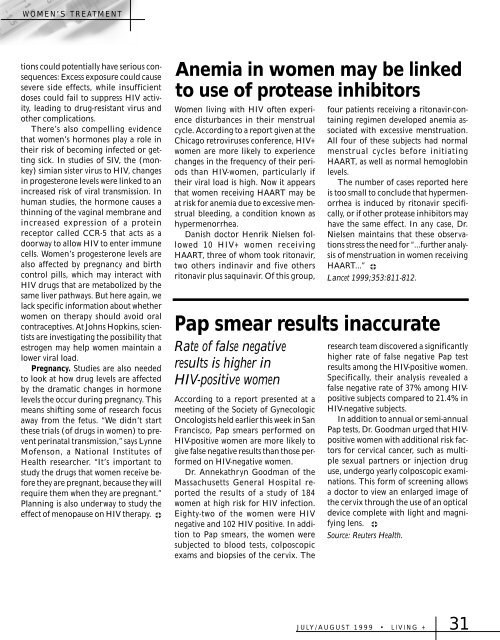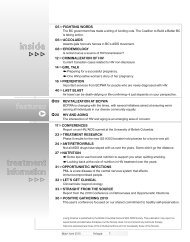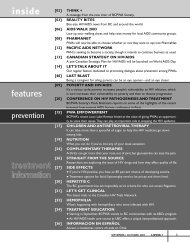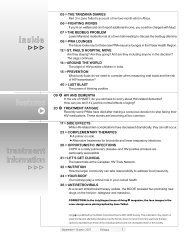Living + Magazine Issue 1 - Positive Living BC
Living + Magazine Issue 1 - Positive Living BC
Living + Magazine Issue 1 - Positive Living BC
Create successful ePaper yourself
Turn your PDF publications into a flip-book with our unique Google optimized e-Paper software.
WOMEN’S TREATMENT<br />
tions could potentially have serious consequences:<br />
Excess exposure could cause<br />
severe side effects, while insufficient<br />
doses could fail to suppress HIV activity,<br />
leading to drug-resistant virus and<br />
other complications.<br />
There’s also compelling evidence<br />
that women’s hormones play a role in<br />
their risk of becoming infected or getting<br />
sick. In studies of SIV, the (monkey)<br />
simian sister virus to HIV, changes<br />
in progesterone levels were linked to an<br />
increased risk of viral transmission. In<br />
human studies, the hormone causes a<br />
thinning of the vaginal membrane and<br />
increased expression of a protein<br />
receptor called CCR-5 that acts as a<br />
doorway to allow HIV to enter immune<br />
cells. Women’s progesterone levels are<br />
also affected by pregnancy and birth<br />
control pills, which may interact with<br />
HIV drugs that are metabolized by the<br />
same liver pathways. But here again, we<br />
lack specific information about whether<br />
women on therapy should avoid oral<br />
contraceptives. At Johns Hopkins, scientists<br />
are investigating the possibility that<br />
estrogen may help women maintain a<br />
lower viral load.<br />
Pregnancy. Studies are also needed<br />
to look at how drug levels are affected<br />
by the dramatic changes in hormone<br />
levels the occur during pregnancy. This<br />
means shifting some of research focus<br />
away from the fetus. “We didn’t start<br />
these trials (of drugs in women) to prevent<br />
perinatal transmission,” says Lynne<br />
Mofenson, a National Institutes of<br />
Health researcher. “It’s important to<br />
study the drugs that women receive before<br />
they are pregnant, because they will<br />
require them when they are pregnant.”<br />
Planning is also underway to study the<br />
effect of menopause on HIV therapy.<br />
Anemia in women may be linked<br />
to use of protease inhibitors<br />
Women living with HIV often experience<br />
disturbances in their menstrual<br />
cycle. According to a report given at the<br />
Chicago retroviruses conference, HIV+<br />
women are more likely to experience<br />
changes in the frequency of their periods<br />
than HIV-women, particularly if<br />
their viral load is high. Now it appears<br />
that women receiving HAART may be<br />
at risk for anemia due to excessive menstrual<br />
bleeding, a condition known as<br />
hypermenorrhea.<br />
Danish doctor Henrik Nielsen followed<br />
10 HIV+ women receiving<br />
HAART, three of whom took ritonavir,<br />
two others indinavir and five others<br />
ritonavir plus saquinavir. Of this group,<br />
four patients receiving a ritonavir-containing<br />
regimen developed anemia associated<br />
with excessive menstruation.<br />
All four of these subjects had normal<br />
menstrual cycles before initiating<br />
HAART, as well as normal hemoglobin<br />
levels.<br />
The number of cases reported here<br />
is too small to conclude that hypermenorrhea<br />
is induced by ritonavir specifically,<br />
or if other protease inhibitors may<br />
have the same effect. In any case, Dr.<br />
Nielsen maintains that these observations<br />
stress the need for “...further analysis<br />
of menstruation in women receiving<br />
HAART...”<br />
Lancet 1999;353:811-812.<br />
Pap smear results inaccurate<br />
Rate of false negative<br />
results is higher in<br />
HIV-positive women<br />
According to a report presented at a<br />
meeting of the Society of Gynecologic<br />
Oncologists held earlier this week in San<br />
Francisco, Pap smears performed on<br />
HIV-positive women are more likely to<br />
give false negative results than those performed<br />
on HIV-negative women.<br />
Dr. Annekathryn Goodman of the<br />
Massachusetts General Hospital reported<br />
the results of a study of 184<br />
women at high risk for HIV infection.<br />
Eighty-two of the women were HIV<br />
negative and 102 HIV positive. In addition<br />
to Pap smears, the women were<br />
subjected to blood tests, colposcopic<br />
exams and biopsies of the cervix. The<br />
research team discovered a significantly<br />
higher rate of false negative Pap test<br />
results among the HIV-positive women.<br />
Specifically, their analysis revealed a<br />
false negative rate of 37% among HIVpositive<br />
subjects compared to 21.4% in<br />
HIV-negative subjects.<br />
In addition to annual or semi-annual<br />
Pap tests, Dr. Goodman urged that HIVpositive<br />
women with additional risk factors<br />
for cervical cancer, such as multiple<br />
sexual partners or injection drug<br />
use, undergo yearly colposcopic examinations.<br />
This form of screening allows<br />
a doctor to view an enlarged image of<br />
the cervix through the use of an optical<br />
device complete with light and magnifying<br />
lens.<br />
Source: Reuters Health.<br />
JULY/AUGUST 1999 • LIVING + 31











